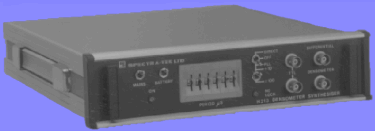
|
Features
|
H213 Frequency Synthesiser
The H213 Synthesiser is designed to provide a convenient and accurate means of simulating frequency domain transducers, such as vibrating cylinder densitometers.
The instrument uses a high quality crystal oscillator to generate an output signal the period of which is set on the front panel 6-decade thumbwheel switches. Using a phase-locked loop synthesiser three ranges are provided, allowing resolutions of 100nS, 10nS or 1nS.
Several output arrangements are provided covering TTL, 12V differential line driver and a 5V, 1kOhm source to represent the typical signals of intrinsically safe transducers.
The instrument is portable and the built-in nickel-cadmium battery can support continuous operation for two hours. When connected to the 100V/230V mains the internal battery is trickle charged.
A 20MHz crystal oscillator is used to drive a 6-decade Modulo N divider whose modulus is set on the period thumbwheels. The output frequency is divided by two giving an output whose period is equal to the switch setting. In "Direct" mode the minimum allowable setting is 00000.2 uS and the maximum is 9999.9 uS.
In "PLL" mode the output period from the Modulo N system is divided by 10 or 100 giving a resolution of 10nS and 1nS respectively. Because of the limited frequency range of the PLL it is necessary to restrict the dialled-in Modulus to figures which place the output approximately in the range 2mS to 200uS. An "out-of-lock" lamp is illuminated when the PLL has failed to acquire the correct output frequency. These restrictions cover the working range of all known density transducers and at the same time allow a period resolution of 1nS to be achieved.